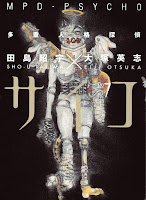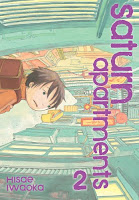My News and Reviews
The Manga Moveable Feast for March is coming up in a couple of weeks (March 20-26), which I believe will be hosted by Linda at Animemiz’s Scribblings. The feast will be focusing on Aria by Kozue Amano. I’ve been meaning to read the series for a while now, so this will be a perfect excuse to finally get around to it.
Arguably the biggest happening in the world of manga last week was the news that Tokyopop will be laying off more of its staff. Brigid Alverson at Robot 6 wrote a passionate response (Tokyopop lays off senior editors) that got quite a few people talking. Daniella Orihuela-Gruber, a freelance editor at Tokyopop, offers a personal response to the news at All About Manga—Life of a (Rookie) Editor: Love and Job Security.
A couple of weeks ago, Jason Thompson (Manga: The Complete Guide) wrote a post for io9 that I almost missed about the insane political satire and mahjong manga The Legend of Koizumi—The Legend of Koizumi: Japanese Politics, Mahjon Action and Space Nazis. It’s not currently available (legally) in English, but I hope that one day it will be. I tried to put a bug in Vertical‘s ear last time they were looking for license requests, but I’m not sure it was noticed.
Last week I announced the Have Some Hetalia Winner and posted the Bookshelf Overload for February. Also, a few more resources have been added to the Resources page: Animanga Nation, Anime, Manga and Manhwa Reviews, Animemiz’s Scribblings, and A Life in Panels (which I thought was already listed, but I guess not). And apparently green was the featured color for this week’s manga quick takes.
Quick Takes
 Legal Drug, Volumes 1-3 by CLAMP. Currently, Legal Drug is on hiatus; there hasn’t been a new volume released since 2003. The first two volumes are somewhat episodic, although hinting at an overarching plot, while the third volume is primarily devoted to a single story. Things can be a bit confusing at times, and occasionally the plot is a little hard to follow, but I do like the overall story so far. Even more, I like the characters. Though, having only three volumes makes it difficult to really get to know them. But they certainly all have their own distinct personalities, and it’s a lot of fun to watch them interact. I found the artwork to be quite nice as well.
Legal Drug, Volumes 1-3 by CLAMP. Currently, Legal Drug is on hiatus; there hasn’t been a new volume released since 2003. The first two volumes are somewhat episodic, although hinting at an overarching plot, while the third volume is primarily devoted to a single story. Things can be a bit confusing at times, and occasionally the plot is a little hard to follow, but I do like the overall story so far. Even more, I like the characters. Though, having only three volumes makes it difficult to really get to know them. But they certainly all have their own distinct personalities, and it’s a lot of fun to watch them interact. I found the artwork to be quite nice as well.
 MPD-Psycho, Volumes 7-9 written by Eiji Otsuka and illustrated by Shou Tajima. I’m still not quite sure I understand everything that’s going on in MPD-Psycho, but I’m still completely fascinated by it. The artwork, too, while vaguely disconcerting is enthralling; it helps emphasize the creepy qualities of the story. I would really like to know what’s going on, so I hope that Dark Horse publishes another volume soon. The series is up to fifteen volumes in Japan, but the the last volume in English was released almost two years ago. Towards the end of last year I heard that Dark Horse planned to resume publishing, but I haven’t seen anything since then.
MPD-Psycho, Volumes 7-9 written by Eiji Otsuka and illustrated by Shou Tajima. I’m still not quite sure I understand everything that’s going on in MPD-Psycho, but I’m still completely fascinated by it. The artwork, too, while vaguely disconcerting is enthralling; it helps emphasize the creepy qualities of the story. I would really like to know what’s going on, so I hope that Dark Horse publishes another volume soon. The series is up to fifteen volumes in Japan, but the the last volume in English was released almost two years ago. Towards the end of last year I heard that Dark Horse planned to resume publishing, but I haven’t seen anything since then.
 Natsume’s Book of Friends, Volumes 1-3 by Yuki Midorikawa. It’s been a while since I read the first volume of Natsume’s Book of Friends; I had forgotten how much I enjoy the series. It was first recommended to me because I liked Yuki Urushibara’s series Mushishi. Both series are primarily episodic, although Natsume’s Book of Friends has more recurring characters. They also both have a sort of nostalgic, melancholy feel to them. Natsume’s Book of Friends tends to have a bit more humor than Mushishi and is more approachable and straightforward for younger readers. But that doesn’t mean older readers won’t enjoy it, too. I know that I certainly do.
Natsume’s Book of Friends, Volumes 1-3 by Yuki Midorikawa. It’s been a while since I read the first volume of Natsume’s Book of Friends; I had forgotten how much I enjoy the series. It was first recommended to me because I liked Yuki Urushibara’s series Mushishi. Both series are primarily episodic, although Natsume’s Book of Friends has more recurring characters. They also both have a sort of nostalgic, melancholy feel to them. Natsume’s Book of Friends tends to have a bit more humor than Mushishi and is more approachable and straightforward for younger readers. But that doesn’t mean older readers won’t enjoy it, too. I know that I certainly do.
 Saturn Apartments, Volume 2 by Hisae Iwaoka. Mitsu continues learning more about himself and his father in this second volume of Saturn Apartments. I’m enjoying watching as he allows himself to grow closer to the people he works with. I’m not entirely sure why, but I absolutely adored the entire conversation revealing Tamachi’s obsession with eggs. It’s amusing to watch everyone hang out and rib on each other. I’m glad the Mitsu is beginning to feel like part of the group, but I do still worry about him. There’s still a fair amount of mystery surrounding his father’s accident; I’m particularly interested in learning more about this aspect of the story.
Saturn Apartments, Volume 2 by Hisae Iwaoka. Mitsu continues learning more about himself and his father in this second volume of Saturn Apartments. I’m enjoying watching as he allows himself to grow closer to the people he works with. I’m not entirely sure why, but I absolutely adored the entire conversation revealing Tamachi’s obsession with eggs. It’s amusing to watch everyone hang out and rib on each other. I’m glad the Mitsu is beginning to feel like part of the group, but I do still worry about him. There’s still a fair amount of mystery surrounding his father’s accident; I’m particularly interested in learning more about this aspect of the story.
 Berserk directed by Naohito Takahashi. I am more or less obsessed with Kentaro Miura’s manga series Berserk, so it was only a matter of time before I picked up the anime as well. The storyline has been streamlined and focused but there were definitely parts that I missed. Some of the emotional impact is reduced, but there were still moments that gave me chills. Susumu Hirasawa’s soundtrack is great. Overall, it’s a fantastic adaptation; the most important aspects and themes of the story remain intact although the supernatural elements are downplayed (at least until the end). The anime does end rather abruptly; it probably could have used one or two more episodes to tie everything together better.
Berserk directed by Naohito Takahashi. I am more or less obsessed with Kentaro Miura’s manga series Berserk, so it was only a matter of time before I picked up the anime as well. The storyline has been streamlined and focused but there were definitely parts that I missed. Some of the emotional impact is reduced, but there were still moments that gave me chills. Susumu Hirasawa’s soundtrack is great. Overall, it’s a fantastic adaptation; the most important aspects and themes of the story remain intact although the supernatural elements are downplayed (at least until the end). The anime does end rather abruptly; it probably could have used one or two more episodes to tie everything together better.











